The Beauty of Violence: An Interview with Marcelo Frusin
Argentinian comic book sensation Marcelo Frusin discusses his artistic process and love of Sergio Leone films in an EXCLUSIVE chat with EM’s Brent Sprecher.
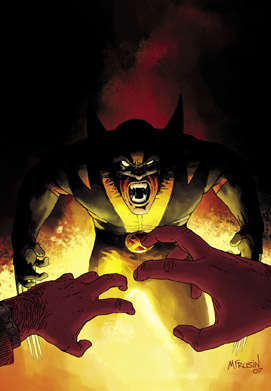 Frusin is unabashedly a fan of westerns, but he has also crossed over into mainstream superhero comics by tackling Magnus, Robot Fighter and the X-Men. Most recently, he astounded fans with his beautifully violent artwork in 2007’s Wolverine Annual tale, “The Death Song of J. Patrick Smitty,” penned by Gregg Hurwitz. The haunting tale follows the guilt-ridden J. Patrick Smitty as he attempts to run from his conscience and the wrath of Wolverine. Hurwitz’s words and Frusin’s art combined to make the tale one of the most compelling Wolverine stories in several years.
Frusin is unabashedly a fan of westerns, but he has also crossed over into mainstream superhero comics by tackling Magnus, Robot Fighter and the X-Men. Most recently, he astounded fans with his beautifully violent artwork in 2007’s Wolverine Annual tale, “The Death Song of J. Patrick Smitty,” penned by Gregg Hurwitz. The haunting tale follows the guilt-ridden J. Patrick Smitty as he attempts to run from his conscience and the wrath of Wolverine. Hurwitz’s words and Frusin’s art combined to make the tale one of the most compelling Wolverine stories in several years.
BRENT SPRECHER: Marcelo, thank you for agreeing to do this interview. I’ve only just discovered your work, but your art on Wolverine Annual #1 (2007) just blew me away. After finishing the issue, I immediately got on the internet to find out what other works you had contributed to and how to contact you.
MARCELO FRUSIN: Thanks, Brent.
BS: Breaking into the comic book business is exceptionally difficult, even when the majority of publishers are in one’s own country. What special difficulties did you encounter trying to break in and has living in South America hindered you in any way?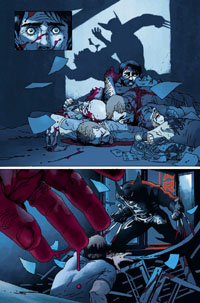
MF: Language and distance are the first difficulties. Living far away forces you to make a bigger effort in many senses. Luckily, things have not been too hard for me. Nowadays, things are simpler because of the internet. Sending your work by FTP is instantaneous, and you can easily be in touch. Also, it’s easier to show your work to many people through your website or blog. Besides, there’s all kinds of information available and the young people can make a lot of exchanges through specific forums.
BS: You’ve said that Moebius’ Arzach was a big influence in your life and in your decision to become an artist. What other artists in the medium influenced you growing up and who inspires you today?
MF: Moebius was that first big impact. The second one was Frank Frazzetta, and then came my studies in Fine Arts and my admiration to painters like Gustav Klimt, Egon Schielle, Francis Bacon and Bruno Giacometti. In comics, I enjoy Mike Mignola, Miguelanxo Prado, Nicolas DeCrecy, Sergio Toppi, Dino Battaglia, Dave McKean, Alex Toth and Frank Miller, among others.
BS: Your style is often called “cinematic” and your frequent collaborator Brian Azzarello described your work as “masculine.” When discussing differences between your art and that of Eduardo Risso, Azzarello said, “I could describe a scene to Eduardo and we’d get a panel of a tooth flying through the air, Marcelo, would give me a boot, a mouth, and a tooth cracking.” Is your art heavily influenced by film, and if so, what films or directors have inspired you?
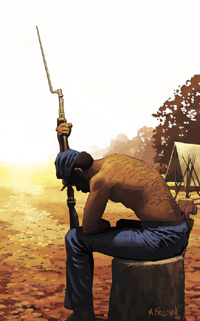 MF: Yes, I have taken several things from cinema. I have studied the illumination of the German expressionist cinema and Orson Welles’ films as well. On the other hand, Sergio Leone’s films are the ones I enjoy the most! I can see them over and over again and I’m fascinated by them each time. The photography and narration are outstanding and music and images are inseparable in his movies. Other film influences include Stanley Kubrick, David Lynch, Francis Coppola, Peckimpah, Tim Burton, Polanski and M. Night Shyamalan. The movies that have inspired me the most are absolutely all of the Leone films, A Clockwork Orange, Apocalypse Now, Dracula, Blade Runner, The Duellists, Wild at Heart, The Godfather, Chinatown, Lawrence of Arabia and many more that I’m not remembering now.
MF: Yes, I have taken several things from cinema. I have studied the illumination of the German expressionist cinema and Orson Welles’ films as well. On the other hand, Sergio Leone’s films are the ones I enjoy the most! I can see them over and over again and I’m fascinated by them each time. The photography and narration are outstanding and music and images are inseparable in his movies. Other film influences include Stanley Kubrick, David Lynch, Francis Coppola, Peckimpah, Tim Burton, Polanski and M. Night Shyamalan. The movies that have inspired me the most are absolutely all of the Leone films, A Clockwork Orange, Apocalypse Now, Dracula, Blade Runner, The Duellists, Wild at Heart, The Godfather, Chinatown, Lawrence of Arabia and many more that I’m not remembering now.
BS: When discussing Loveless, Azzarello mentioned an affinity for spaghetti westerns, describing Loveless as a “noir spaghetti western.” You’ve mentioned several times before your love of westerns. Growing up in Argentina, did westerns saturate popular culture like they did here in the States or did you have to seek them out?
MF: They were very popular here. When I was a child, I lived for the spaghetti westerns. Some years later, I saw some of them again and rediscovered Sergio Leone; I got enchanted. Then I saw some other spaghetti westerns by other directors and I waited to find in them the grandiosity of Leone, but it just didn’t happen. There are just a few Italian westerns that are really good. I also like many of the American-made westerns.
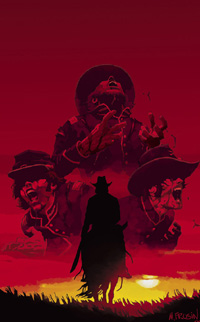 BS: If you had to choose… John Wayne or Clint Eastwood?
BS: If you had to choose… John Wayne or Clint Eastwood?
MF: Clint Eastwood, no doubt. Although, there’s some Wayne films that I like a lot.
BS: How much reference do you use when working on a period piece like Loveless?
MF:A good many. Not only do I use it for costumes and atmosphere, but also as inspiration. I look at pictures, I see movies, I read and when I’m drawing a western I listen to Morricone’s music and Italian western soundtracks, which are great; most of them even better than the movies.
BS: Are you able to make it to the States for comic conventions? The San Diego Comic Con is quite a spectacle to behold.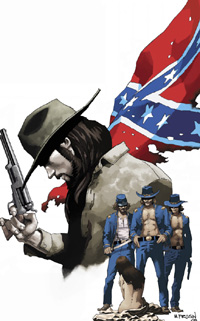
MF: Yes, I went to the San Diego Con two times. It’s a good spectacle as you said, and it’s also good to talk with editors, readers and colleagues.
BS: You’ve had a long-standing relationship with DC Comics, but you recently provided art for Wolverine Annual #1 for Marvel Comics. Are you freelance now?
MF: Yes. That allows me to choose with more freedom those projects that captivate me the most.
BS: I think you were the perfect choice to illustrate Gregg Hurwitz’s tale, “The Death Song of J. Patrick Smitty,” in Wolverine Annual #1. The moodiness you infused in your pages truly conveyed the desperation, guilt and fear of Mr. Smitty. How did you become attached to the project?
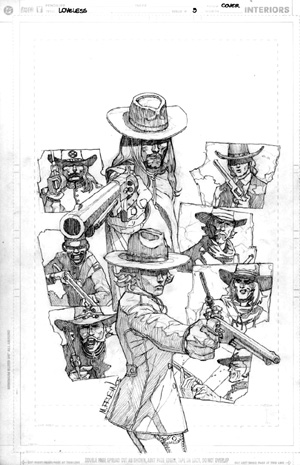 MF: It was a proposal by (Marvel editor) Axel Alonso. It was my first painted comic and it was a great satisfaction. I had been wanting to do it for a long time. I really liked Gregg’s edition, to see Wolverine through the eyes of Smitty, a poor burglar full of blame and repentance, who sees Wolverine as a demon that would punish him and make him pay for his sins.
MF: It was a proposal by (Marvel editor) Axel Alonso. It was my first painted comic and it was a great satisfaction. I had been wanting to do it for a long time. I really liked Gregg’s edition, to see Wolverine through the eyes of Smitty, a poor burglar full of blame and repentance, who sees Wolverine as a demon that would punish him and make him pay for his sins.
BS: I remember you saying in a previous interview that it takes you about six weeks to pencil, ink and do the cover for an issue. Wolverine Annual #1 was 36 pages and you also colored the issue. How long did it take, beginning to end?
MF: Since I was working on other projects at the same time, it’s hard for me to tell you how much time it took me exactly. Besides the time you mentioned, the color takes me 3 or 4 hours per page, depending on the page.
BS: Could you describe your “process” for us? What tools do you use?
MF: I pencil in the traditional way, I do a sketch and then I define it. Then I ink with a common pen and I retouch what it is necessary digitally. At the beginning, I used a wacom tablet, but I bought a Cintiq a while ago, so I’m coloring with it now.
BS: The great body of your work has been in dark crime noir and western tales, but you seemed right at home with the character of Wolverine. Did you make the switch to a superhero tale because it interested you or is it simply that the genre dominates the market?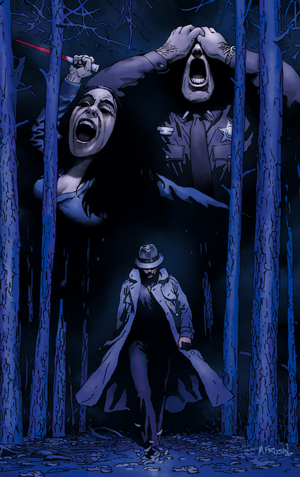
MF: I like to try new things. This annual has a dramatic and dark atmosphere that attracted me, and Wolverine is one of the superheroes that I like the most.
BS: You worked on Niko Slavo for Intrepido Magazine, an Italian publication. Are you still working for any European companies?
MF: Yes, for Dargaud in France, since 2007.
BS: There are obvious differences between American comics and their European counterparts. As an artist, do you find yourself having to change your style or pacing to suit the market?
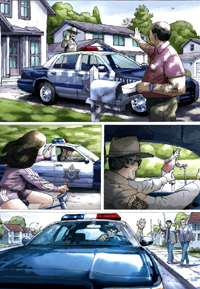 MF: Fortunately, they never asked me that I change my style…so far. Generally, editors call you to do something because they like your style. If I change something, it’s to experiment, improve. As for pace, in France, which is the heart of the European comic scene, it’s calmer than in US. It can allow you, among other things, to do creator-projects with script, art and colors all by yourself.
MF: Fortunately, they never asked me that I change my style…so far. Generally, editors call you to do something because they like your style. If I change something, it’s to experiment, improve. As for pace, in France, which is the heart of the European comic scene, it’s calmer than in US. It can allow you, among other things, to do creator-projects with script, art and colors all by yourself.
BS: What would be your dream project?
MF: The first one would be a western with the soul of the Sergio Leone’s films, written and painted by me. I would like to do something set during WWII, or something with Vikings or Romans… Horror, fantasy and science fiction are all genres that I love. All historic periods have a charm for me.
BS: Many of today’s most talented comic book artists make the jump to animation. Does that hold any appeal for you?
MF: Maybe. I could work on the design of characters and backgrounds, but I’m really pleased with comics.
BS: What’s on the horizon for you? Any “secret” projects you can give us the scoop on?
MF: Apart from the stuff in the US and France, I’m working on a creator-owned project. I’m just starting it. It will be a painted work, a western.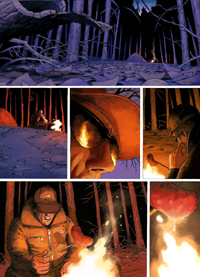
BS: Finally, do you have any advice for young artists striving to break into the business?
MF: (Artists) need to make (art) their way of living, even though they may have to do works that hey don’t like so much sometimes. (These projects) allow you to practice all of the time. Then, do not forget to drive your career to where they like the most, taking some risks at times. I think the only way to get to do something really interesting is to do what motivate and obsesses you the most.
BS: Marcelo, thank you so much for your time. We’ll be watching for you!
MF: You’re welcome, Brent. It was a pleasure!
In addition to his work in North and South America, Marcelo has worked for European publishers of comic books. He provided artwork for the “Niko Slavo” series in Intrepido, an Italian magazine published by Universo, and he has just completed work on Lengedes Urbaines (Urban Legends) 2, for French pulisher Dargaud.
To see more of Marcelo Frusin’s incredible artwork, click on the following link to go to his blog:
Marcelo Frusin’s Blog
If you’re dying to own your own piece of Marcelo Frusin art (or you’re just curious about the prices), click on the following link to go to SplashPageArt.com:
Marcelo Frusin art for sale!
Check out all of Brent Sprecher’s exclusive interviews with today’s hottest comic book professionals!
Click HERE for an exclusive interview with UK sensation Liam Sharp!
Click HERE for an exclusive interview with Secret Invasion artist Leinil Yu!
Click HERE for an exclusive interview with Hero By Night creator DJ Coffman!
Click HERE for an exclusive interview with Jaded Publishing’s Andrew Chung!
Click HERE to watch an exclusive interview with award-winning writer Grant Morrison!
Click HERE for an exclusive interview about Bluewater Productions’ latest comic adventure, Spaced Out!
DISCLAIMER: This posting was submitted by a user of the site not from Earth's Mightiest editorial staff. All users have acknowledged and agreed that the submission of their content is in compliance with our Terms of Use. For removal of copyrighted material, please contact us HERE.